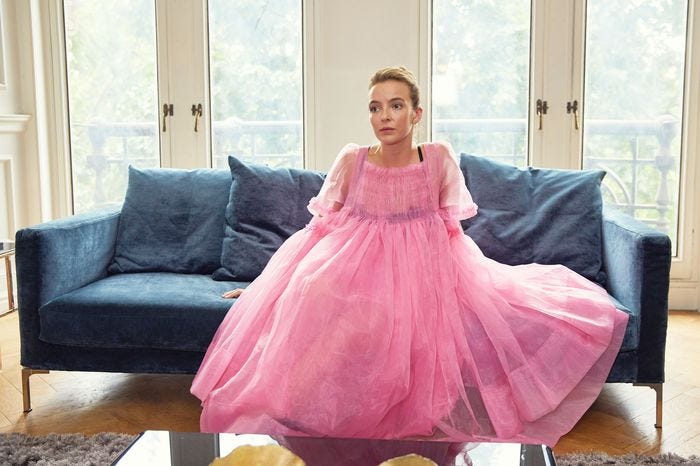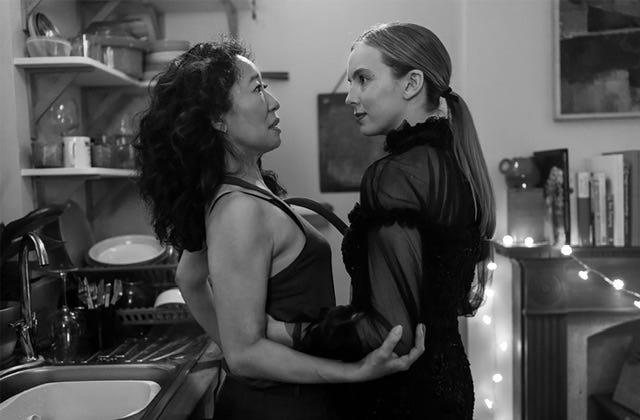WeekEnd Binge Recommendation: “Killing Eve”
I love the new flock of admirable women, but I miss Villanelle, the adorable psychopath
In my “TV Watch” section of BordoLines, I’ve written about the lawyers of “The Good Fight” and “Perry Mason’s” Della Street, women who are conscientious, feminist but not ostentatiously so, mature, sensible, have a sense of humor, and are very, very intelligent. And now there’s “The Diplomat,” in which Keri Russell is smarter than everyone else in the room—and despite the fact that she sweats a lot and doesn’t appear to own a blow-drier, has at least two men pursuing her. These characters, in different ways, mix it up in ways that challenge the televisual cliches about “women in a man’s world.”
I like these women, and I like that scriptwriters are no longer punishing ambitious women with lousy sex lifes, alcoholism, ungrateful children, and all the other cliches which try to balance the cultural scales. But I gotta say I miss the radically messed up female characters of “Killing Eve.” Even Shiv Roy of “Succession,” who is far from virtuous and has major intimacy problems for sure, is the soul of normalcy when compared with Villanelle (Jody Comer) and Eve (Sandra Oh.)
I should admit that shows about serial killers and psychopaths would be my guilty pleasure if I actually felt guilty about them, which I don’t. But lovable serial killers are a rare breed. What we typically enjoy about these characters is the chill of pure evil, like Hannibal Lector, who savors a fine chianti and fava beans along with human body parts. Supposedly, actual (non-fictional) psychopaths can be quite charming when they want to be—it’s how they ensnare their victims—but it’s hard to think of a fictional psychopath who charms the viewer. Our one lovable killer, Dexter, doesn’t count, as he has the redeeming feature of having been taught by his father to channel his psychopathy into killing only bad guys. The show never goes beyond good and evil; it’s about the struggle between good and evil.
Killing Eve did go beyond—everything: genre, recognizable politics, sexual stereotypes, conventional notions about love and sex, and even what counts as a fashionable outfit. Villanelle, the female assassin, may be evil—but she’s also whimsical, undefinable, and irresistible, and much of the pleasure of the show came simply from watching her: her ever-changing facial expressions (giggling or pouting like a five-year-old one moment, coldly eyeing her next victim in another), her clothing (sometimes fashionably butch, sometimes as pink and poufy as a little girl at a beauty pageant, other times like a little boy who couldn’t care less, sometimes simply bizarre), her unpredictable moves and moods.
It’s impossible to figure her out. Did she kill the boy in the hospital bed next to hers on impulse, possibly as an act of euthanasia, or simply to steal his stickers? Does she herself even know? Whatever; she looks far more fetching loping down the street, her tummy bulging out of his stolen Target boy sleepwear, than Ally McBeal did prancing around in her oversized pajamas with the little sheep on them. We can almost forgive the fact that she is a sadistic murderer because she gives us so much pleasure with her fashion choices, and they give her so much pleasure, too. (She is barely able to force herself to wear a nurse’s dowdy slippers, in order to escape from the hospital.)
Eve isn’t a natural-born killer, but she’s weird, too. It’s fairly easy to understand the magnetic pull Villanelle exerts over her; she discovers that she needs doses of danger to keep her heart going. But what’s the nature of Villanelle’s attraction to Eve? It’s sexual but not primarily, it’s not about Eve’s great, big hair (which Villanelle does love), and it’s not just admiration—although it’s clear Villanelle does admire something in Eve that other people lack. But what is it? Villanelle may be a trickster, but Eve is just . . . unfathomable. She seems normal in many ways, but it’s a foggy sort of normal, a walking sleep that only Villanelle is able to wake her out of. And even when awake, she seems not to know what she’s doing with herself half the time, even as she has an instinctive brilliance for investigation. Eve and Villanelle seem to be in love with each other (which causes them to “do crazy things”—as Villanelle says—like try to kill each other) but to make those words “in love” apply, they need to be reinvested with something that isn’t within my vocabulary—and certainly isn’t found in the conventions of romantic/sexual relationships, depicted in movies and TV, even the kinkier ones.
Some reviewers have tried to slot Killing Eve within recognizable, if transgressive, categories: Melanie McFarland, in Salon, describes it as a “feminist thriller” for the era of #MeToo, that “slakes one’s desire to see piggish misogynists get what’s coming to them” by having them dispatched cold-bloodedly by the disarmingly pretty and seductive Villanelle while complicating the simplicity of sisterhood by making her as dangerous to the woman she’s irresistibly drawn to—Eve—as to the men she disdains. Along those lines, Willa Paskin in Slate writes that the show warns the viewer that underestimating women is dangerous. They may appear, as Villanelle frequently does, as hyperfeminine; but her hairpin is a deadly weapon.
But Villanelle isn’t your typical femme fatale. Her emotional life is more like that of a child. She likes to play, to goof around. She is drawn to toys, then throws them away carelessly. At one point, after murdering an infant’s mother, she picks up the baby and seems to take genuine delight in playing with it. But she soon tires of it, is annoyed by its crying, and when her old mentor Dasha (Harriet Walker) dumps the baby in a nearby trash can, indifferently walks away.
The scene is both shocking and darkly funny and reprises a similar sequence of events that takes place when we are first introduced to Villanelle, in an outdoor café, where she is staring at a little girl eating ice cream and smiling at her mother. Wanting to catch the little girl’s attention, Villanelle works at copying her smile, and it isn’t clear whether this is someone with an absence of human emotion trying to fake it or she’s just awkwardly being friendly. The little girl is wary at first—why is this stranger smiling at me?—but eventually smiles back and is rewarded by having her ice cream dumped onto her dress. The scene is a perfect introduction for a character who will always keep us off balance, and a feminist message seems forced and irrelevant to either her, Eve, or their relationship with each other. They are profoundly strange people, the show is “hilarious, bloody, [and] unclassifiable,” and it’s enough that it’s so enjoyable to watch.
A lot of shows since “Killing Eve” have adopted the genre of dark comedy—“Succession” probably being the most notable. But the only character in “Succession” who approaches the weirdness of Eve and Villanelle is Lukas Mattson, who sends packages of his frozen blood to the woman he’s dating, and whose motives are the subject of endless debate on fan pages of the show. Mattson is also, like Eve, impossibly attractive.
If you didn’t see “Killing Eve” the first time it came around, all four seasons are streaming on Hulu, Apple TV, and Amazon Prime.
QUOTES FROM:
https://slate.com/culture/2018/04/bbc-americas-killing-eve-reviewed.html
https://www.rollingstone.com/tv/news/killing-eve-tv-review-w520147
This post is excerpted from TV, my contribution to the Bloomsbury “Object Lessons” series.







Far from perverse. Poetic justice. And she should kill the dancing baby too.
Also-- this particular piece I think illustrates perfectly why I think we get along. Maybe this subject would be a good one for us to collaborate on, although I don’t know what form something like that would take. The subject: that we are at war with ourselves, when we ask art to be better than society, but then we keep being reminded that art giving us better people/less prejudice and less prejudice-based and malevolent power-based characters and stories is not necessarily as entertaining.